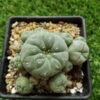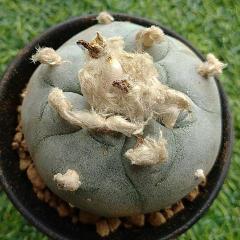L.W cactus plant 5 to 5.5 cm diameter
$85.00 Original price was: $85.00.$84.00Current price is: $84.00.
Buy Lophophora Williamsii plants Online – Exploring L.W Cactus Plants 5 to 5.5 cm Diameter
L.W. Peyote Cactus plants, specifically those with a diameter of 5 to 5.5 cm, are an intriguing subset of the diverse Cactaceae family. Cacti are primarily native to the Americas and are well-adapted to arid environments, showcasing unique physiological traits that enable survival in harsh conditions.
Physical characteristics of peyote cacti: Cacti typically exhibit a variety of shapes and structures. The 5 to 5.5 cm-diameter cacti often feature ribbed or fluted stems, which allow for efficient water storage and absorption. These ribs expand when the cactus is hydrated and contract during droughts, showcasing their remarkable adaptability23. Additionally, many cacti possess spines derived from specialized structures called areoles, which serve as both a defense mechanism and a means of reducing water loss through transpiration.
Growth and Habitat of Cacti Plants: These cacti thrive in environments characterized by high temperatures and low moisture levels. They can be found in deserts, scrublands, and even tropical rainforests, depending on the species. Their growth habits vary widely; some may grow as solitary specimens while others cluster together, forming dense colonies that can provide mutual protection against environmental stressors.
Ecological Importance of Peyote Cactus: Cacti play a crucial role in their ecosystems. They provide habitat and food for various wildlife, including pollinators such as bees and birds. The flowers of these cacti are often brightly colored and tubular, attracting these essential pollinators during their brief blooming periods. Moreover, they contribute to soil stabilization and can improve soil quality by adding organic matter as they decompose.
Cultivation and uses of petote: Beyond their ecological roles, L.W. Cactus plants are popular in ornamental gardening due to their unique aesthetics and low maintenance requirements. They are also studied for their potential uses in agriculture, particularly as forage crops in arid regions due to their high water efficiency and nutritional value45. In summary, L.W. Cactus plants with diameters of 5 to 5.5 cm exemplify the resilience and adaptability of cacti in challenging environments while serving vital ecological functions and offering aesthetic appeal in cultivation.
Peyote Cactus (Lophophora Williamsii plants) Frequently Asked Questions
Peyote cactus (Lophophora williamsii) is a small, spineless cactus native to the Chihuahuan Desert in Mexico and parts of Texas. It is renowned for its psychoactive properties, primarily due to the presence of mescaline, a compound that induces hallucinations and altered states of consciousness. Here are some frequently asked questions regarding Peyote.
-
What are the growing conditions for Peyote? Peyote thrives in hot, dry environments, requiring well-draining soil and bright, indirect sunlight. Ideal temperatures range from 70°F to 90°F (21°C to 32°C) during the growing season. Watering should be minimal; the soil must dry out between waterings to prevent root rot.
-
How is peyote cactus harvested? Harvesting involves cutting the green part of the plant while leaving the subterranean stem intact, allowing for regrowth. It is recommended to rotate harvesting sites and re-harvest every eight years to ensure sustainability. This practice helps protect wild populations from overharvesting, which has made peyotes vulnerable due to habitat loss and unsustainable practices.
-
Is peyote cactus legal to cultivate? The legal status of peyote varies by region. In the United States, its use is protected for Native American religious ceremonies under the Indian Religious Freedom Act. However, possession and cultivation outside these contexts are illegal for non-Native individuals.
-
What are the health effects of consuming peyote cactus? While peyote has historical uses in spiritual and medicinal contexts, it can cause adverse effects such as nausea, anxiety, and emotional instability when consumed. Its psychoactive properties can lead to hallucinations and other psychological reactions, making it essential to approach its use with caution.
-
How long does it take for peyote to mature? Peyote is a slow-growing cactus that can take over ten years to mature from seed. Cultivators must exercise patience and provide consistent care throughout this period.
Buy Peyote Cactus Review and Recommendations—Lophophora Williamsii plants
Lophophora williamsii, commonly known as Peyote, is a unique and slow-growing cactus native to Mexico and the southwestern United States. Known for its distinctive spineless appearance and psychotropic properties, it has garnered attention both as a collector’s item and for its cultural significance in various indigenous rituals.
- Buying Experience and Recommendations: When purchasing Lophophora williamsii, many customers recommend sourcing from reputable suppliers like buypeyotecactusonline.com. Reviews highlight the excellent customer service provided by sellers such as Byron, who ensure that plants are well packaged and arrive in optimal condition. Customers report satisfaction with the health and appearance of the plants, often noting their vibrant colors and robust growth upon arrival.
-
Care Instructions for Peyote Cactus: Caring for Peyote requires specific attention to its environmental needs.
- Substrate: A gritty mix with minimal organic material is ideal for drainage.
- Watering: Water infrequently from spring to autumn (April to September), allowing the soil to dry out completely between waterings.
- Light: Place the cactus in a south-facing window or greenhouse to ensure it receives ample sunlight.
-
Growth Considerations for Peyote Cactus: Peyote is notoriously slow-growing; it can take several years to reach flowering size. Typically, it grows about 1 cm per year after an initial 2-3 years of development. This slow growth makes it a labor of love for enthusiasts. Furthermore, due to overharvesting in the wild, Lophophora williamsii is considered endangered, emphasizing the importance of responsible cultivation practices.
-
Final Thoughts for Peyoye Cactus: For those interested in cultivating Lophophora williamsii, patience and proper care are essential. The plant not only adds beauty to any collection but also serves as a reminder of its cultural heritage and ecological importance. Engaging with knowledgeable suppliers can enhance the experience, ensuring healthy plants and valuable insights into their care.
10 reviews for L.W cactus plant 5 to 5.5 cm diameter
Add a review Cancel reply
Related products
Lophophora Williamsii plants
Lophophora Williamsii plants
Lophophora Williamsii plants
Lophophora Williamsii plants
Lophophora Williamsii plants
Peyote Cactus For Sale – Lophophora Williamsii – 3 Buttons (4-5 cm Each, Includes Pot)
Lophophora Williamsii plants
Lophophora Williamsii plants

















68wim –
Scratch cards are such a fun, quick thrill! Reminds me of discovering new games on platforms like 68wim – so much variety! Thinking of checking out the 68win app download for some mobile fun. Localized platforms really get what players want! 👍
phlwin –
That’s a great point about game accessibility! Seeing platforms like phlwin online casino app cater specifically to Filipino players with GCash & PayMaya is awesome – truly inclusive gaming! Makes jumping in so much easier. 👍
phlboss –
That’s a great point about balancing challenge & accessibility in shooting games! Seeing platforms like phlboss game focus on a smooth experience for Filipino players is cool – makes gaming more inclusive & fun for everyone! 👍
33wim –
Really interesting read! Seeing platforms like 33wim games focus on a smooth, localized experience for Vietnamese players is a smart move. Easy registration & funding are key – makes getting started so much simpler! 👍
999phl –
Interesting read! Seeing how tech is changing gaming is fascinating. The speed & security aspects of platforms like 999phl login, with AI & blockchain, really stand out. It’s a new era for players!
bossjl –
It’s fascinating how easily accessible online gaming has become, especially in the Philippines. Seeing platforms like BossJL streamline registration & deposits-even with the bossjl app casino-highlights how behavioral rewards drive engagement. It’s about minimizing friction!
superph11 –
I’ve tried several platforms, but SuperPH stands out with its smooth interface and great game selection. The bonuses are generous, and I appreciate the fast withdrawals. Check it out at SuperPH11.
jl boss –
Interesting read! The psychology of chasing wins is fascinating, especially with platforms like jl boss legit offering so many game options. Secure transactions & quick onboarding are key for trust, right? 🤔
j8ph –
Interesting read! Seeing more focus on KYC & secure access – crucial for platforms like J8PH. Streamlined logins & legit accounts build trust. Check out the j8ph app download apk for a smooth experience, but always gamble responsibly!
2jl –
Interesting read! Seeing platforms like 2jl casino emphasize RNG & KYC is reassuring – data integrity really matters. Smart move focusing on the Philippines market too! Hoping for consistent payouts. 😉